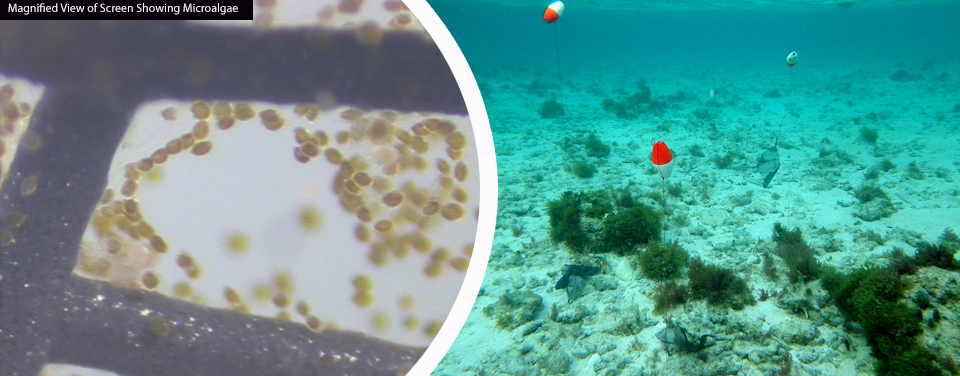NOAA Opens a Window (Screen) on the World of Toxic Algae
A new innovation delivers a low-cost way to sample microscopic algae.

Screening for Tiny Algae in the Name of Human Health
Low-cost fiberglass screens help scientists gather samples for monitoring toxin-producing algal cells. Until now, sampling and monitoring microalgae has been difficult and expensive. Inset: a close-up view of microalgae collected by the screens. The toxins produced by some microalgae can accumulate in fish and shellfish and make people who eat them ill, disrupting the food supply and limiting the development of fisheries.
Using little more than a common window screen, scientists at NOAA’s National Centers for Coastal Ocean Science have developed a simple, low-cost tool to monitor harmful bottom-dwelling algae in diverse marine habitats around the world.
A Simple Solution
The fiberglass screens mimic the natural surfaces that harbor microalgae—microscopic species that inhabit both marine and fresh water. Scientists simply place the screens in the water, remove them after a predetermined amount of time, and compare the algae adhering to them to algae from other locations. Field experiments in tropical environments showed that toxin-producing microalgal cells were sufficiently mobile to colonize screens suspended near the sea floor within 24 hours.
The abundance of algal cells attaching to the screens was highly correlated with the abundance of algae found in the surrounding environment. Until now, sampling and monitoring microalgae has been difficult and expensive, given its broad distribution over such diverse surfaces such as seaweeds, corals, sea grass, and rocks.
Why Monitoring Microalgae is Important
The toxins produced by some microalgae can accumulate in fish and shellfish and make people who eat them ill, disrupting the food supply and limiting the development of fisheries. Some of the most threatening of these algae belong to the genus Gambierdiscus, which produces the toxins that cause ciguatera fish poisoning. Globally, ciguatera is the most common cause of non-bacterial poisoning associated with eating fish.
The new NOAA-developed method of monitoring microalgae with screens is a simple and low-cost innovation that has the potential for wider adoption in coastal communities around the world to aid in the detection of harmful algal blooms.
Get Social
More Information
Did you know?
Ranging from microscopic, single-celled organisms to large seaweeds, algae are simple plants that form the base of food webs. Sometimes, however, their roles are much more sinister. A small percentage of algal species produce toxins that can kill fish, mammals, and birds, and may cause human illness. Learn more
